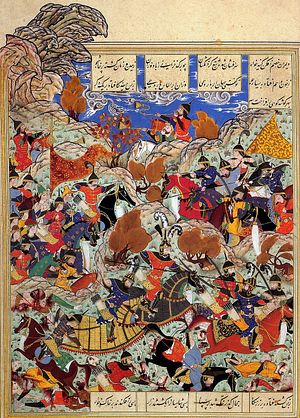Over 100 years after his death and thousands of miles from the extreme edges of his empire, Timur showed up in a British play. Christopher Marlowe’s 1587 Tamburlaine the Great, a play in two parts, takes Timur’s name and alters just about everything else. The Central Asian conqueror intent on resurrecting the Mongol empire is recast as a Scythian shepherd with a brutal dream to conquer the world.
It can be debated whether Marlowe’s version of Timur should be interpreted as praise or not. Part I depicts a virtually superhuman Tamburlaine marching across continents, while Part II ends with his death and includes some of his most brutal acts (both the fictional and real Timur committed atrocities in the name of conquest).
In one analysis of the play (referenced in an introduction to one edition here), Paul Kocher writes “what the end of the play leaves us with, is simply the conclusion that death comes even to the mightiest. Tamburlaine’s life is not condemned; it is praised; its magnificence was its goodness.” Part II, nonetheless, depicts a series of brutal acts. Toward the end of Part II, Marlowe’s Tamburlaine hitches the King of Jerusalem and the King of Natalia (Anatolia) to his chariot and hangs the Governor of Babylon from the city’s walls in chains. He then orders the people of Babylon to be drowned (all of them, children included) and burns piles of Qur’ans, referred to in the play as “heaps of superstitious books.”
Marlowe’s perspective–that Timur was terrible but magnificent–might have have roots in the sources he turned to in writing the play. Howard Miller, examining the role of migration and translation in grounding Marlowe’s Tamburlaine, wrote that he might have had accessed Timur through translated Arabic sources along with what Miller calls “eastern sources.” This could explain the two extremes represented in the play.
Eastern sources, such as Persian historian Sharaf ad-Din Ali Yazdi’s biography of Timur, are hagiographic in tone whereas Arab histories of Timer are more critical. Yazdi uses one of Timur’s sources of power and legitimacy–Islam–to justify the cruelties of his other source–his designs to resurrect the Mongol empire through conquest. Yazdi’s work is effusive in its praise and characterizes Timur’s many atrocities as necessary steps taken by a man of great purpose, sent by God to bring order to Asia.
The world might then be well compar’d to a human body, which being infected with some corrupt matter, necessarily falls sick and can receive no benefit but from a strong medicine, which purges out the cause of the disease… In the same manner, God, who was pleas’d to purge the world, made use of a medicine, which was both sweet and bitter, to wit, the clemency and the wrath of the incomparable Timur; and to that effect, inspir’d in him an ambition to conquer all Asia… But yet he cou’d not accomplish this great affair, without bringing in some measure upon the places he conquer’d, destruction, captivity, and plunder, which are are the concomitants of victory.
Arab accounts of Timur are less kind, the conqueror more a devastating plague than a strong medicine. Timur, nonetheless, is still depicted by Arab sources–such as Ibn Khaldun’s first-hand account of his meeting with Timur outside Damascus in 1401–as intelligent and even courteous. Timur had heard that Khaldun, a historian in the Mamluk Sultan’s court, was in the city. The Sultan’s forces had fled for Egypt, leaving Khaldun and those in Damascus to debate surrendering to the Mongols at the gates. Khaldun was lowered in a basket from the walls of Damascus to meet the notorious conqueror. The two discussed geography and politics, even arguing about Nebuchadnezzar. In his history, Khaldun recounted Timur’s taking of Damascus, his siege on the citadel, his forces’ plundering of the city and a fire that destroyed part of the Great Mosque. But even Khaldun, who called this destruction “an absolutely despicable and abominable deed” added a divine caveat, “but the changes in affairs are in the hands of God. He does with His creatures as He wishes, and does with His kingdom as He wills.”
In Miller’s words, the account by Muhammad ibn Arabshah, another Arab historian, was “unstintingly hostile.” Arabshah, the son of a religious scholar, had been forced to migrate from Damascus to Samarkand. Timur had a habit of removing scholars of all kinds from the cities he conquered and sending them back to his court. Eventually, Arabshah made his way back to the Middle East, ending up in the court of Sultan Muhammad I, the son of Bayazid–whom Timur had defeated and captured. Arabshah’s account, Miller wrote, was his “literary revenge on the destroyer of Damascus.”
Timur and Marlowe’s Tamburlaine are complex characters; and all we have to go on are historical accounts (and countless translations and retranslations), each of which have their own flaws. Still, it’s an astounding thing to think about: a Central Asian conqueror ended up starring in a play by one of Shakespeare’s contemporaries.

































